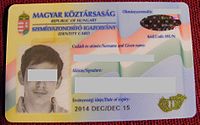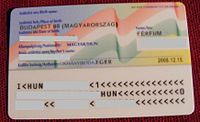- Hungarian identity card
-
Hungarian identity cards are compulsory for Hungarian citizens from 14 years of age, although they may be obtained by anyone after birth. Since 1 January 2006, it is possible for citizens to travel anywhere within the Schengen Area, the European Union and certain other European countries (such as Macedonia[1]) using only this card.
Currently, there are three types of valid identity documents (Személyi igazolvány, abbr. Sz.ig.). The oldest valid one is a hard-covered, multi-page book issued before 1989 by the People's Republic of Hungary; the second type is a soft-cover, multi-page book issued after the democratic change of the state. These two documents both have one, original photo of the owner embedded, with original signatures of the owner and the local police's representative. The third, accepted since 2000, is a plastic card, usually called a Personal Identity Card, with the photo and the signature of the holder digitally reproduced.
The card shows the owner's full name, maiden name if applicable, birth date and place, mother's name, sex and validity period, as well as the local state authority which issued the card. The card has a unique identification string composed of six numbers and two letters. It does not have any information about the owner's residential address, nor their Personal ID—this sensitive information is contained on a separate card, called the Authority ID. The Personal ID, which originated in the Communist era, is no longer used as an identification number, but only a statistical signature.
Other valid documents are the passport (blue or red, containing an RFID chip) and the driver's license; an individual is required to have at least one of them on hand at all times. The Personal Identity Card is mandatory to vote in state elections or open a bank account in the country.
References
- ^ "Information for Foreign Citizens". Republic of Macedonia, Ministry of Foreign Affairs. http://www.mfa.gov.mk/default1.aspx?ItemID=305. Retrieved 17 January 2011.
National Identity cards By continent AfricaAsiaPeople's Republic of China (Hong Kong SAR • Macau SAR) • India • Indonesia • Iran • Israel • Malaysia • Pakistan • Philippines • Saudi Arabia • Singapore • Sri Lanka • South Korea • Republic of China (Taiwan)1OceaniaEuropeAlbania • Austria • Belgium • Bosnia and Herzegovina • Bulgaria • Croatia • Cyprus • Czech Republic • Estonia • Finland • France • Germany • Gibraltar • Hungary • Italy • Lithuania • Macedonia • Malta • Moldova • Montenegro • Netherlands (BES) • Poland • Portugal • Romania • Serbia (Kosovo1) • Slovakia • Slovenia • Spain • Sweden • SwitzerlandNorth AmericaSouth AmericaNotes 1 Partially unrecognised and thus unclassified by the United Nations geoscheme. It is listed following the member state the UN categorises it under.
Biometric identity cards ( ) are indicated in italics.Categories:
) are indicated in italics.Categories:- Government of Hungary
- National identity cards by country
Wikimedia Foundation. 2010.


